But first some history
What is a Coat of Arms?
In the 12th century, knights began wearing helmets that completely concealed
their faces except for two narrow slits for the eyes. It made a knight unrecognizable
to both his friends and his enemies. Therefore, symbols such as lions or other beasts were painted
on the knights’ shields and banners to aid in recognition during a battle. As time
went on these decorations were repeated on the surcoat (a sleeveless garment that
was worn over armor) —therefore the name, coat of arms.
Other social classes who never would march in battle also began to assume arms for themselves. Initially, those closest to the lords and knights adopted arms, such as persons employed as squires that would be in common contact with the armorial devices. Then priests and other ecclesiastical dignities adopted coats of arms, usually to be used as seals and other such insignia, and then towns and cities to likewise seal and authenticate documents. Eventually by the mid 13th century, peasants, commoners and burghers were adopting heraldic devices. The widespread assumption of arms led some countries to regulate heraldry within their borders. However, in most of Europe, citizens freely adopted armorial bearings.
QUESTION: What is the difference between Family Crest and a Coat of Arms?
ANSWER: There is a technical difference between a family 'Crest' and a 'Coat of Arms', but people often use the terms interchangeably. A 'Coat of Arms' (full achievement) generally refers to the shield, crest, helmet, mantling and supporters (if any), while the 'Crest' technically only refers to the small image that lies on the helm (top of the helmet). A Coat of Arms that bears a name was originally bestowed to an individual.
WHO CAN HAVE A COAT OF ARMS?
Anyone has the right to bear a coat of arms. Arms can be held by persons, countries, corporations and families. You will most likely find a family crest for the original spelling of your family name. If you have traced the records back to an ancestor who had the original spelling, then it is still your coat of arms, even though the name may be spelled differently in your line today.
Moreover, in most countries there is no legal requirement attached to coats of arms. You may design and display anything you like, including the coat of arms of someone who bore your surname whether you are directly related to him or not. There are bodies that will register coats of arms, but there is no legality involved here.
Picture below: Detail of our work. Handwork in silk and silver thread

|